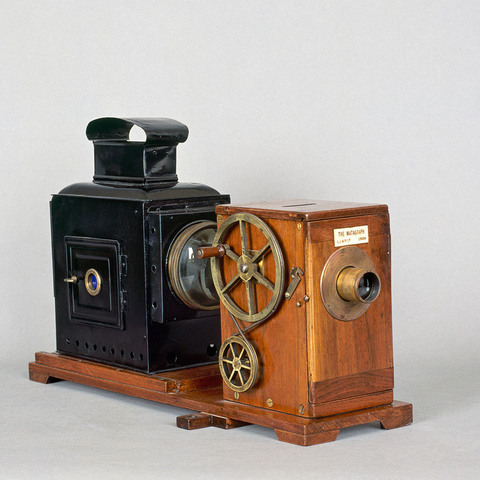Projecteur de film 35 mm
Fiche détaillée
Type de l'appareil
entraînement du film 35 mm par une croix de Malte à quatre branches ; un débiteur denté ; obturateur à boisseau ; deux roues d'entraînement ; poulie sur le côté gauche ; manivelle ; objectif à crémaillère ; lanterne de projection en métal peint
Auteurs
Informations non disponibles
Fabricants
Alexander S. Jones
Londres, 71 Farringdon Road
Samuel J. Levi
Londres, 71 Farringdon Road
Utilisateurs
Informations non disponibles
Distributeurs
Levi, Jones & Co LTD
Londres, 71 Farringdon Road
Sujet du modèle
Informations non disponibles
Objectif
4 lentilles 3,5 cm Ø (double Petzval achromatique)
Taille de l'objet
Ouvert :
Informations non disponibles
Fermé :
Longueur : 57 cm
Largeur : 22.5 cm
Hauteur : 36 cm
Diamètre :
Informations non disponibles
Taille de la boîte de transport
Informations non disponibles
Remarques
Étiquette d'ivoire posée sur le devant : "The Matagraph L. J. & Co. LTD. London".
La pellicule tombe à travers un trou pratiqué au fond de l'appareil. Poulie sur le côté gauche. Il existe quatre modèles différents du Matagraph. Ce modèle était vendu £12,60 à la fin de 1898.
"Levi, Jones & Co., Ltd., makers of Cameras, Lanterns & the Matagraph. The New Model Combination "Matagraph" for projecting films or lantern slides, greatly improved. Price complete, £12, 12s. Now admitted the most successful machine made. No flicker, no torn films, absolute steadiness, no danger. The reversing effects that can be obtained with this machine are most novel and unique. No prism necessary. Made only by Levi, Jones & Co., Ltd., 29 Hoxton Square, London" (The Photographic Dealer, August 1898, p. i).
"Levi, Jones & Co. Ltd, who the previous year had introduced the French Rollograph on the English market, now in 1898, issued two further machines, the Matagraph and the Cynnagraph. The former was a well-made projector selling at £6 and was reputed to be one of the cheapest on the market. It may have been first introduced towards the end of 1897, but the earliest reference to it I have found, is dated 25 February 1898, by which time 200 of the machines had already been sold. During the course of its existence, the projector was constantly being improved and at least four different models are known. What may be the earliest form of the apparatus is preserved in the Barnes collection, but unhappily, in an incomplete state. It consists of a polished mahogany case with a hinged door at the front giving access to the mechanism inside. Two hinged doors, or flaps, open out at the top to support a metal hanger on which the roll of film is placed. The film is then fed through the machine and avanced by a single sprocket-wheel which has an intermittent movement applied to it by a Maltese-cross. The film finally issues through a hole in the bottom of the case and presumably falls into a suitable receptacle underneath, as no take-up spool is provided. A crank-wheel turns on a fixed spindle on one side of the case and is connected by a crossed band to a pulley on the main driving shaft. A flatt brass plate, pivoted at one corner, is attached to the back of the case to act as a safety shutter or light cut-off. Immediately behind the gate is a small two bladed shutter which revolves like an ordinary barrel-type shutter, but in this case the blades are flat and not curved. A description of the apparatus in "Photography Annual for 1898", tells us : "The lantern body is of Russian iron with cowl and tray for jet, and fitted with 4in compound condenser. It is arranged so as to slide along the baseboard for adjustment. The lens is a double achromatic Petzval combination of 2,5 in focus, and at 28 ft. will project a picture 10 ft x 7 ft 6 in. The whole instrument is fitted into a stout case, with lock and key and handle, and T screws with bushes are issued to permit the Matagraph to be fixed on to the top of its case". Later in the year, the Matagraph was much improved and the price was increased to twelve guineas (£12.60). It will be observed that by a single deplacement of the film projector, slides are well as films could be shown. In this newer model, the light cut-off was improved and provision was made for a larger spool of film. We are informed that the nature of the escapement enabled a film to be reversed simply by cranking the handle in the opposite direction. Reverse action could thus be shown without the need for a reversing prism. A Matagraph projector in the Science Museum differs [...] : it should be noted that the extra wooden pulley on the driving shaft of the Science Museum example has been added to provide a driving band to the take-up spindle, which unfortunately is missing. The model, although incomplete, resembles somewhat the one shown in a illustration from the "Monthly Supplement" to the "British Journal of Photography", of 3 June 1898. After the introduction of the new regulations passed by the London County Council in November, a special auxiliary safety shutter, which worked automatically, was provided for the Matagraph. It was designed in such a way that it automatically opened and closed immediately the projector was started off stopped" (John Barnes, Pioneers of the British Film, London, Bishopsgate press, 1983, p. 105-107).
Bibliographie
Photography Annual for 1898, Londres 1898, p. 645.
The Photographic Dealer, August 1898, p. i.
John Barnes, Pioneers of the British Film, London, Bishopsgate press, 1983, p. 105-107.
